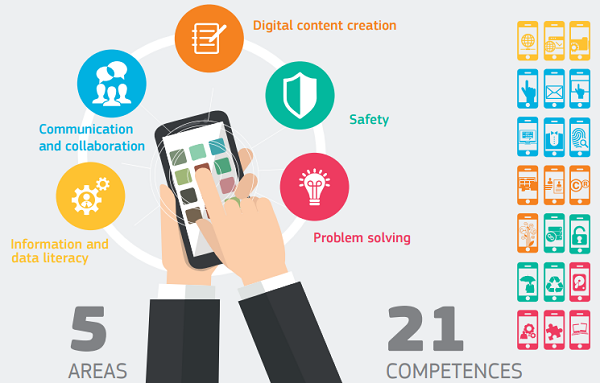Digital competence: the vital 21st-century skill for teachers and students

What is digital competence?
Digital competence is one of the eight key competences and refers to the confident and critical usage of the full range of digital technologies for information, communication and basic problem-solving in all aspects of life. This may sound simple to many of us but, according to the Digital Agenda Scoreboard 2015, 40% of the EU population has an insufficient level of digital competence, including 22% who do not use the Internet.
It is also important to consider that “as a transversal competence, digital competence also helps us master other key competences, such as communication, language skills, or basic skills in maths and science,” as Riina Vuorikari wrote in her expert article.
To understand the nature of this competence better, the European Commission has developed the European Digital Competence Framework for Citizens (DigComp) which is divided into five areas: information and data literacy; communication and collaboration; digital content creation; safety; and problem solving. Together they include 21 competences – click the picture below and see in the infographic how many of them you are confident in already!
In the near future, the educators will have their own framework, called DigCompEdu. In its preliminary proposal we find six areas of development including professional environment; creating and sharing digital resources; managing the use of digital tools; assessment; empowering learners; and facilitating learners’ digital competence. Follow the news on this initiative!
How is digital competence developed in Europe?
The Eurydice report (2012) shows us that almost all European countries have a specific national strategy related to digital competence. At the time of the study, digital competence was taught through a cross-curricular approach in all but two EU countries at primary level and in all countries at secondary level – in addition to other approaches used in several countries such as integrating ICT into particular subjects or teaching it as a separate subject.
Providing teachers with sufficient digital competence is a key factor: the latest OECD’s TALIS study (2013) showed that 18% of trainers and teachers feel that they need more development of ICT skills for teaching and 16% on the use of new technologies in the workplace.
The largest teacher network in Europe, eTwinning, provides a good environment for teachers to collaborate with peers and learn about new ways of using ICT for teaching. The eTwinning study (2015) showed that 29% of teachers felt that eTwinning had a large impact on their technology skills for teaching and 37% reported that the impact was at least moderate. eTwinners also reported an increase in their digital teaching and learning practices, e.g. participation in online courses (78%), collaborative creation of materials with students (77%), or use of social networks with students (76%).
How can I promote digital competence in my classroom?
It is widely believed that the development of digital competence should start at an early age but decisions as to the types of technologies and amount of time spent with them should be carefully considered. For example, the principles of coding can be learned using paper cups or building blocks. This European Science in School article explains how.
Talking Pictures is an award-winning eTwinning project that engaged students in lower primary school using photographs and video as the language to communicate and interpret the tales they wished to tell. The children learned that things are not always as they seem – photos can be manipulated to show different points of view.
If you are interested in knowing about an effective whole-school approach to digital tools, read the expert article by Luis Fernandes, a Portuguese head teacher.
In the following Education Talks video, Esther Wojcicki shares her ideas on how to apply project-based learning and digital tools in the classroom.
Educators interested in online training can find interesting online course materials in the European Schoolnet Academy. Please note that the courses mentioned below are finished, but all the materials remain available for self-study. Stay tuned also for reruns, and for new courses!
- Introducing Technology-Enhanced Teaching: learn what Technology-Enhanced Teaching (TET) competence is, how much you have of it, and how to develop more. (Created by the EU-funded MENTEP project)
- Developing Digital Skills in your Classroom: learn how to develop a range of digital skills and discover tools and resources to do that. (Created by the European Commission’s eSkills for Jobs campaign)
- Online Safety Course: learn about online safety, an integral part of digital competence. (Created by the EU-funded Better Internet for Kids (BIK) portal)

